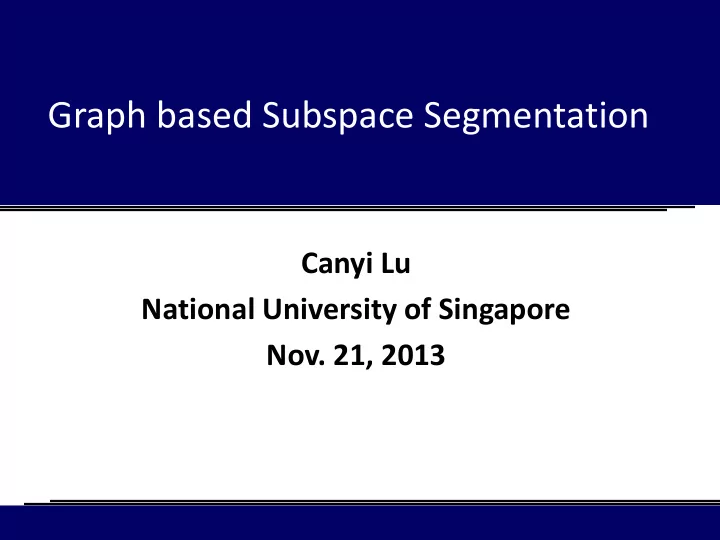

Graph based Subspace Segmentation Canyi Lu National University of Singapore Nov. 21, 2013
Content Subspace Segmentation Problem Related Work • Sparse Subspace Clustering (SSC) • Low-Rank Representation (LRR) • Multi-Subspace Representation (MSR) • Subspace Segmentation via Quadratic Programming (SSQP) • Least Squares Regression (LSR) Enforced Block Diagonal Conditions Correlation Adaptive Subspace Segmentation (CASS)
Subspace Segmentation Given sufficient data points drawn from multiple subspaces, the goal is to find • the number of subspaces • their dimensions • a basis of each subspace • the segmentation of the data corresponding to different subspaces
Applications Face clustering Motion segmentation Image segmentation
Algorithm Spectral Clustering : Graph construction: construct a graph (affinity matrix) to measure the similarities between data points Segment the data points into multiple clusters
Subspace Assumption Disjoint subspaces Independent subspaces Orthogonal subspaces
Previous Work: SSC Graph construction by sparse representation The solution to the above L1 minimization problem is block diagonal when the data are from independent subspace. Bin Cheng, Jianchao Yang, Shuicheng Yan, Yun Fu, Thomas S. Huang, Learning with l1-graph for image analysis. TIP, 2010 Elhamifar, E. and R. Vidal. Sparse Subspace Clustering. CVPR 2009
Previous Work: LRR Graph construction by low rank representation The solution to the above nuclear norm minimization problem is block diagonal when the data are from independent subspace. Liu, G., Z. Lin, S. Yan, J. Sun, Y. Yu and Y. Ma. Robust recovery of subspace structures by low-rank representation. TPAMI. 2013
Previous Work: MSR Graph construction by low rank representation The solution to the above minimization problem is block diagonal when the data are from independent subspace. D. Luo , et al., “Multi - subspace representation and discovery,” in ECML, 2011
Previous Work: SSQP Subspace Segmentation via Quadratic Programming The solution to the above nuclear norm minimization is block diagonal when the data are from orthogonal subspace. Shusen Wang, Xiaotong Yuan, Tiansheng Yao, Shuicheng Yan, Jialie Shen. Efficient Subspace Segmentation via Quadratic Programming. AAAI. 2011.
Least Squares Regression Subspace Segmentation via Least Squares Regression The solution to the above minimization is block diagonal when the data are from independent subspace. Grouping effect of LSR (in vector form) Canyi Lu, Hai Min, Shuicheng Yan. Efficient Subspace Segmentation via Least Squares Regression. ECCV. 2012.
Consider the following general problem What kind of objective function involves the block diagonal property under certain condition? Canyi Lu, Hai Min, Shuicheng Yan. Efficient Subspace Segmentation via Least Squares Regression. ECCV. 2012.
Enforced Block Diagonal Conditions Canyi Lu, Hai Min, Shuicheng Yan. Efficient Subspace Segmentation via Least Squares Regression. ECCV. 2012.
Block Diagonal Property: independent subspaces Canyi Lu, Hai Min, Shuicheng Yan. Efficient Subspace Segmentation via Least Squares Regression. ECCV. 2012.
Block Diagonal Property
Block Diagonal Property : orthogonal subspaces Block diagonal property when the subspaces are orthogonal
Block Diagonal Property : disjoint subspaces Block diagonal property by SSC on disjoint subspaces Elhamifar, E. and R. Vidal. Clustering disjoint subspaces via sparse representation. ICASS, 2010
Block Diagonal Property : disjoint subspaces Block diagonal property by LSR on disjoint subspaces
Correlation Adaptive Subspace Segmentation A better choice: balance the sparsity and grouping effect Correlation Adaptive Subspace Segmentation (CASS) If the data are uncorrelated (the data points are orthogonal ) If the data are highly correlated (the data points are all the same, ) For other case, C. Lu, et al. Correlation Adaptive Subspace Segmentation by Trace Lasso. ICCV. 2013.
Correlation Adaptive Subspace Segmentation CASS also leads to block sparse solution when the data are from independent subspace. Grouping effect of CASS C. Lu, et al. Correlation Adaptive Subspace Segmentation by Trace Lasso. ICCV. 2013.
Correlation Adaptive Subspace Segmentation Comparison of different affinity matrices
Experiments: Motion Segmentation
Experiments: Face Clustering
Thanks!
Recommend
More recommend